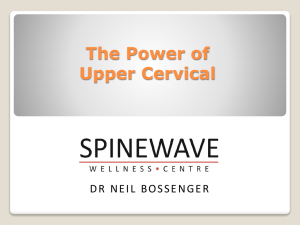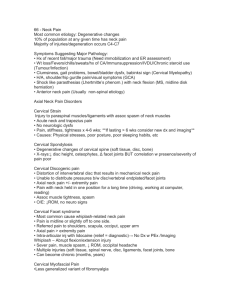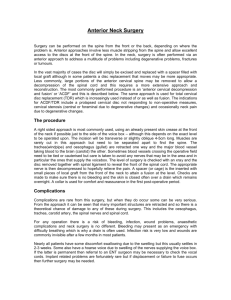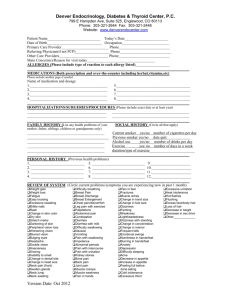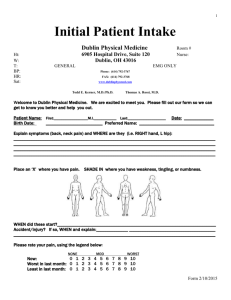Cervical Injuries
advertisement
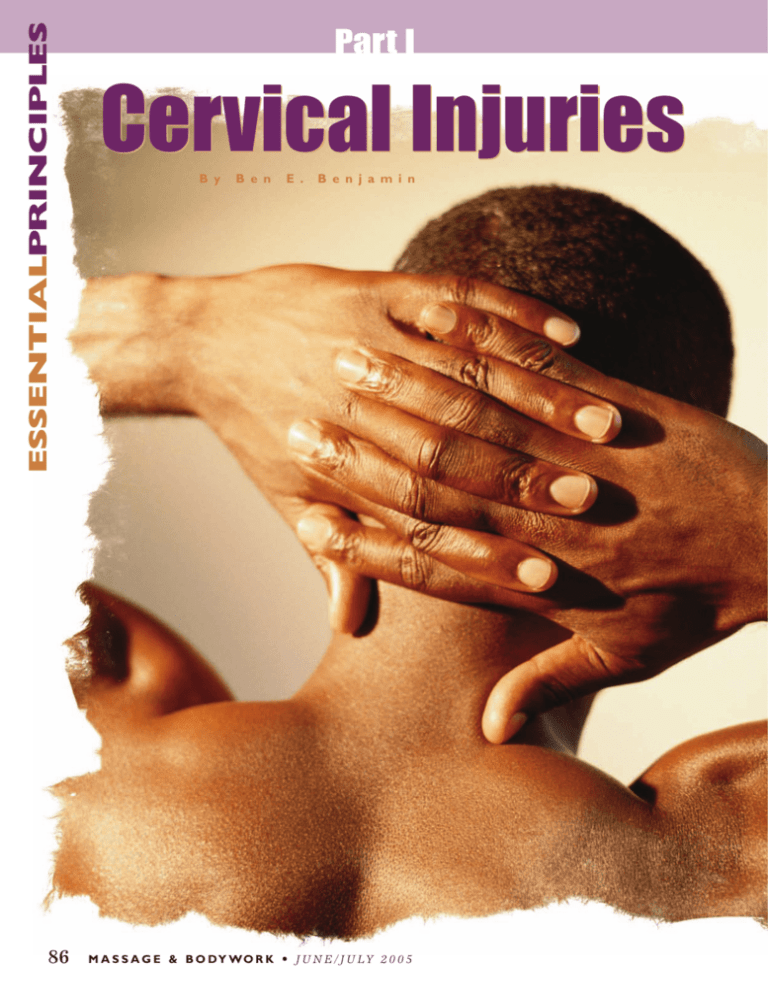
ESSENTIALPRINCIPLES 86 Part I Cervical Injuries B y B e n E . B e n j a m i n M A S S A G E & B O DY WO R K • J U N E / J U LY 2 0 0 5 ervical injuries are second in prevalence only to those in the lumbar region. In fact, it is rare to find anyone who has not suffered from neck pain at some point in life. Individuals with constant neck pain number in the millions. Although some of this pain is due to traumatic whiplash injuries, the cervical area can become injured and painful without suffering a trauma. When a client describes waking up in the morning unable to turn her head without pain, this often means there is an injury in the cervical area. Pain and other uncomfortable phenomena resulting from neck injuries are often misunderstood. A searing pain in the shoulder blade, a burning sensation down the arm, and a numbing, crawling sensation in the hand can all be the result of injuries to various structures in the cervical region. Let’s begin by looking at the anatomy of this very important area. C Figure 1— Intervertebral disc. The Anatomy of the Cervical Region here are seven cervical vertebrae. The bony prominences at the lowest portion of the back of the neck are the ends of the long, protruding spinous processes. Transverse processes are smaller bony extensions located laterally on each side of the neck. (You cannot readily feel these unless you know what to look for.) Thousands of ligament fibers run between the bony prominences of the spine, giving it strength and stability. Injuries to the supraspinous, interspinous, and intertransverse ligaments in this area are the source of much recurrent or longstanding cervical pain. Between the main bodies of the vertebrae lie the shock-absorbing discs. The discs in the cervical region are thicker than those in the thoracic spine. This extra cushioning helps protect the neck, which is capable of more varied movement and is therefore more vulnerable to injury. The discs are made of fibrocartilage and have no feeling; an injured disc does not cause pain directly. Pain, numbness, weakness, or tingling sensations are felt when a disc protrudes and presses on one of the nerves that exit through the small holes (foramina) between the vertebrae and keep branching out through the body. T Figure 2 — A disc protrusion (A) can press on a nerve and cause pain. The primary function of the cervical muscles is to help you balance your head on top of your spine. In addition, the muscles in the posterior cervical region allow you to look up at the ceiling, and those in the anterior region help you tilt your head forward. The lateral cervical muscles help you rotate your head and side flex your neck. The muscles of the neck aren’t usually very strong because they don’t need to be — except, of course, if you’re a wrestler, boxer, or football player. It’s often difficult to determine the location of injuries in the cervical region. In the following J U N E / J U LY 2 0 0 5 • M A S S A G E & B O DY WO R K 87 essential principles sections, we’ll examine two sources of confusion: the phenomenon of referred pain and the common misperception that pain often originates primarily in the muscles. Is It a Cervical Injury? ervical injuries are frequently quite difficult to identify. Many structures in the cervical region refer pain to other areas of the body, which can cause great confusion for massage therapists and other health professionals. C Essential Principle: An in-depth understanding of referred pain — pain felt at a location some distance from its source — plays a critical role in our ability to effectively assess and treat injuries throughout the body. Pain may be referred from a variety of structures in the neck. The broad tendinous attachments in the occipital region can refer pain to the front of the head. Various ligaments in the neck can refer pain to the eyes, jaw, teeth, upper shoulder, medial border of the scapula, chest, axilla, upper back, upper arm, lower arm, wrist, hand, and fingers. Adhesive scar tissue in the cervical region can lead to severe headaches and pain felt as far away as the lowest aspect of the medial border of the scapula. Protruding discs that press on nerve roots and nerve trunks can cause everything from searing pain to pins and needles to experiences of numbness in the upper limbs. Certain neck lesions can even cause weakness in the legs. There are four principles of referred pain to keep in mind when evaluating injuries: 1. Pain is usually referred distally, not proximally. For example, pain may be referred from the neck to the wrist and hand, but not from the wrist to the neck and shoulders. 2. Referred pain does not cross the midline of the body. If an injured disc is pressing on a nerve root on the right side of the neck, it will not refer pain down the left arm. 3. The farther the pain is referred from the source of the injury, the more severe the injury. For instance, a mild ligament sprain in the neck might refer pain to the shoulder and upper arm, while a severe one would refer pain to the elbow or the hand. 4. Pain is referred in specific pathways, called dermatomes. For example, an injured ligament or nerve in the neck may cause pain down the front or back of the arm, because certain areas of the neck are in the same dermatome (C5, C6, or C7) as parts of the upper arm and forearm. 88 Figure 3 — Referred pain patterns in the head and neck region from injuries to cervical discs 1, 2, and 3. Figure 4 — Referred pain patterns in the arm and hand from injuries to cervical discs 5, 6, 7, and 8.) In the neck, there is an additional referred pain factor. Ligaments and discs tend to refer pain in different ways. M A S S A G E & B O DY WO R K • J U N E / J U LY 2 0 0 5 ¨ When there is a disc injury, pain is frequently felt only distally. For example, a disc injury in the neck may cause pain or pins and needles only in the arm and hand. When a ligament refers pain, it is usually felt closer to the source of the injury, for example in the shoulder, upper arm, and scapula regions. When you encounter a client with pain in the neck/shoulder/arm area, first try to establish whether the problem originates in the cervical region or in the shoulder. One indication of a cervical injury is pain that begins or gets worse when the client moves the head in certain directions. If the neck becomes painful after holding the head in a fixed position for a period of time (such as when painting a ceiling, typing at a computer, or holding a telephone between the shoulder and the ear), this also suggests a cervical injury. Pain initiated by moving the arm (lifting the arm above the head, scratching the back, lifting something, and so on) is most likely caused by a lesion in the shoulder. Cervical and shoulder injuries are often confused with one another. Without specialized knowledge and training, it can be difficult to distinguish upper arm pain caused by a cervical injury from that caused by a rotator cuff injury. Unfortunately, it’s also common to have both a cervical and a shoulder injury at the same time, creating two similar, overlapping pains. To successfully alleviate the pain, it is important to discover and treat both injured areas. Which Structure is Injured? n addition to the uncertainty caused by referred pain, there is frequently some confusion about which type of structure might be injured. Many people think chronic neck pain comes from strained or sore muscles in the cervical region, but most often it is caused by problems with ligaments — even though the subjective feeling is that the muscles hurt. I also cause pain, but they occur less frequently. Another possible cause is a ruptured disc pressing on a nerve. However, that scenario is the culprit in less than 5 percent of cases, according to surgeons. In the case of the neck, tight or stiff neck muscles are the source of many people’s complaints, but are seldom the primary cause of pain. Actual ruptures of neck muscles occur very rarely, and minor microtears when they do occur cause only short-lived discomfort. The muscles are well vascularized, and healing takes place very rapidly. Muscle spasm as the major cause of neck pain is another misconception. Muscle spasm is generally a secondary phenomenon, a protective response triggered by movements that begin to impinge on an injured structure, such as an inflamed ligament. The knots you may feel are generally caused by muscles contracting involuntarily to protect the neck. The presence of a muscle spasm doesn’t help you determine what’s injured. Muscle spasms occur with many kinds of injuries: a torn ligament or tendon, a disc pressing on a nerve, irritation within a joint, an infection, cancer of the spine, or a severe tear in a muscle. Microscopic tears and the resulting adhesive scar tissue in the ligaments of the neck are the most prevalent forms of cervical injury and the most common culprits in chronic neck pain. When these tears heal poorly into matted scars and adhesions, pain and limitation of movement in the cervical region can continue for years. As discussed in the previous section, the client often feels the pain or discomfort at least several inches away from the actual injury site. When the neck ligaments are sprained, the head and/or neck may ache on one or Essential Principle: Muscle spasm is a secondary phenomenon. In the early days of my career, I believed that almost all pain problems originated in the muscles. I even wrote a book about it. But my work and study over the last 25 years has shown me that this assumption was incorrect. I discovered that muscle tension is a precursor to injury (see “The Tension Factor” on page 91) but not the actual cause of pain in most cases. Bone misalignments, sprained and torn ligaments, and poorly formed adhesive scar tissue are the main causes of both neck and back pain. Of course, diseases such as ankylosing spondylitis and cancer of the spine 90 Figure 5 — Ligament Injuries • Supraspinous ligament injury:The ligament at the back of the neck (A) is torn. • Interspinous ligament injury:The ligament between the vertebrae (A1) is torn. • Intertransverse ligament injury:The ligament at the side of the neck (B) is torn. M A S S A G E & B O DY WO R K • J U N E / J U LY 2 0 0 5 essential principles both sides, or the person may feel sharp pain on one side only. Pain can also radiate down toward the scapula or the chest or down the arm. Usually the supraspinous, interspinous, and intertransverse ligaments tear at the back and the sides of the neck respectively. How Cervical Injuries Occur evere neck injuries can make life miserable for months or years. They may result from a fall, a head-on collision in an athletic event, or a car accident — particularly one involving whiplash. (Whiplash refers to an injury that occurs when the head is thrust violently forward and then snapped back; it is not a precise diagnostic term.) All of these events cause tears in ligaments and other structures that are often quite painful. Less serious damage to neck ligaments is fairly common in everyday life. Often a person will wake up with neck pain from sleeping in an awkward position that has excessively stretched and inflamed the ligaments. The body tries to protect the torn ligament fibers by initiating an involuntary muscle spasm that limits movement in that area. This phenomenon often accounts for the feeling of stiffness in the neck. If this pain continues for any length of time, trigger areas of localized muscle pain also develop in addition to the primary injury. In other cases, cervical pain appears slowly, for no apparent reason. Frequently the ligaments are weakened over a period of months or years from being forcefully stretched beyond their limit, as happens in stretching exercises performed incorrectly or for too long. In addition, chronic tension held in the neck weakens the ligaments, as well as hampering circulation and affecting the mobility and general health of the neck. Nutritional deficit is another factor that decreases the integrity of ligament structures. A diet lacking in essential minerals, salts, vitamins, proteins, carbohydrates, and fats contributes to the conditions that make ligament failure more likely. S The Tension Factor How does excessive muscle tension affect the health of ligaments? We know ligaments hold the bones of the spine together to create and support our physical structure. But they also have another function: surrounding and supporting the discs. To perform both of these functions, the ligaments are held taut. If the spaces between the discs decreases too sharply, however, they go slack. A certain amount of compression in the spine is natural. Throughout the course of every day, the discs are compressed by supporting the weight of the head and the body. Some of the water contained in each disc diffuses through the disc membrane into the vertebral body, and the disc flattens out a little bit. When you lie down to sleep, the moisture returns and the disc swells again to its original size. Most of us are a little bit taller when we wake in the morning than when we go to bed at night. It is also normal for disc spaces to narrow somewhat with age, as the discs harden over time. Often, however, excess muscle tension causes these spaces to narrow prematurely. There are hundreds of muscles in the erector spinae muscle group that flank the vertebrae from the neck to the sacrum. Some span one or two vertebrae, while others span three or more. If these muscles are chronically tense, as they are in many people, they constantly exert a compression force even greater than that of gravity and therefore squeeze the vertebrae more forcefully together. Such unnatural compression leaves the supporting ligaments that surround the discs in a routinely slackened state. If a ligament goes slack for any significant period of time, it begins to weaken and atrophy. Ligaments, like muscles and bones, maintain their strength and integrity through regular use. When a weakened ligament is repeatedly called on to perform quick, sudden actions, it will stretch or tear slightly. Previously benign activities like a J U N E / J U LY 2 0 0 5 • M A S S A G E & B O DY WO R K 91 essential principles When a person is injured in the cervical or lumbar region, weakness generally indicates that a ruptured (commonly called “slipped”) disc is impinging on a nerve. The muscles receive their orders from the brain through the nervous system via electrical impulses. When a ruptured disc causes intense pressure on a nerve, the impulses can no longer get through easily, and therefore the muscle cannot work properly. As a result, degeneration begins and muscle bulk and strength decrease. One clear example of weakness caused by a cervical injury is loss of control of the hand while writing or gripping. Weakness in a specific area may also indicate the person is suffering from a serious disease. Whenever you discover an instance of severe weakness, have the client see a physician as soon as possible. quick turn of the head, looking over your shoulder to back up your car, or extending your head slightly as you look up to catch a ball can cause mini-tears and traumas to the cervical ligaments. In addition, when people with weakened ligaments hold a neck stretch for too long or receive frequent high-velocity neck manipulation, the ligaments are more prone to stretch and tear. Understanding Symptoms and Warning Signs n addition to pain and discomfort, cervical injuries can sometimes cause weakness or a pins-and-needles sensation. It’s important to understand the possible sources of these symptoms and to be alert for indications of a serious injury or disease. I Pins and Needles (Tingling) We’re all familiar with the feeling of pins and needles associated with part of our body “falling asleep.” This tingling sensation can sometimes be a sign of a serious problem. When such symptoms occur continuously or with great frequency in the hands and/or feet, this often means there is direct pressure on the spinal cord and a physician should be consulted right away. If the tingling is felt occasionally in just one body part (one hand, foot, arm, or leg), it is not necessarily a serious issue. For example, when a person sits in one position for too long, the leg falls asleep as a result of pressure on the nerve trunk in the thigh. In this case, the pins-and-needles sensation is only the waking up of the nerve as circulation returns. Another relatively benign cause of this sensation is positional pressure on an artery: Certain body positions can cause temporary partial occlusion of the arterial blood flow to an area of the body. In the arm and hand, this may happen to the subscapular or axillary artery. When the person moves, removing the pressure on the artery, this may cause a tingling or pins-and-needles sensation. This is again the experience of circulation returning to that part of the body. In Conclusion Weakness Severe muscle weakness — to the extent that a person feels he has lost control of part of his body — is usually a sign of serious trouble. A leg may feel as though it’s going to collapse, or a lifting task that used to be easy may seem impossible. A person may get tired very rapidly doing something simple, such as trying to open a jar. This weakness can occur in an arm, hand, leg, or foot and is often accompanied by a noticeable change in the size of the muscles in that area. Sometimes muscle weakness and atrophy (shrinking of muscle mass) are very obvious, but at times they are subtle and can hardly be noticed, especially in the early stages. 92 n this article, we’ve begun to develop an understanding of cervical injuries — sources of great distress for many clients and much confusion for practitioners. We examined the anatomy of the cervical region and discussed the ways cervical injuries occur and the types of symptoms they cause. The next article will provide detailed guidelines for identifying the most frequently injured cervical ligaments. M B I & Ben Benjamin, Ph.D., holds a doctorate in education and sports medicine. He is the founder and president of the Muscular Therapy Institute in Cambridge, Mass., and has been in private practice for 40 years. He is the author of Listen to Your Pain, Are You Tense? and Exercise Without Injury. He can be contacted at bb@mtti.com. M A S S A G E & B O DY WO R K • J U N E / J U LY 2 0 0 5
